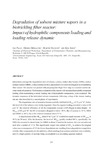Degradation of solvent mixture vapors in a biotrickling filter reactor: impact of hydrophilic components loading and loading release dynamic

Ver/
Use este enlace para citar
http://hdl.handle.net/2183/12829Coleccións
Metadatos
Mostrar o rexistro completo do ítemTítulo
Degradation of solvent mixture vapors in a biotrickling filter reactor: impact of hydrophilic components loading and loading release dynamicData
2007Cita bibliográfica
Biotechniques for Air Pollution Control II, 2007: 357-365. ISBN: 978-84-9749-258-4
Resumo
[Abstract] Interactions amongst the degradation rates of toluene, xylenes, methyl ethyl ketone (MEK), methyl isobutyl ketone (MIBK), n-butyl acetate (n-BA), and acetone (Ac) were investigated in a biotrickling filter reactor. The reactor was packed with polypropylene High-Flow rings in a counter-current airwater mode of operation. Performance evaluation of the reactor with increased hydrophilic compound loading while maintaining a steady loading rate of hydrophobic components, were evaluated. The dynamic responses of the individual solvent components following a drop of the ketone loading rate are also described in a second phase of experiments. The degradation rate of aromatics became partially inhibited at OLKET of 15 g.m-3.h-1; below this level all of the ketones were totally degraded. Once the organic loading exceeded a value of 40 g.m-3.h-1 the removal efficiency of all the components (except n-BA) began to drop sharply. At OLKET of 85 g.m-3.h-1 the RE of aromatics dropped to below 10 %, that of acetone to 10 %, MEK and MIBK to 20 %, but n-BA removal remained above 97 %. A step-decrease of the OLKET from 85 to 5 g.m-3.h-1 resulted in a rapid increase of REAROM to 30 % (in 20 min). After the decrease, the level of REKET quickly reached 90 %, specifically: for MEK this occurred in about 4 min, for MIBK in about 25 min but for acetone, this was not achieved until after a period of 3.5 h. The significantly longer time period of REAc to achieve the original value was a consequence of: (1) its slower degradation rate resulting from a degradation competition with the other components, (2) the inhibitory effect resulting from acetone unlimited water solubility, and (3) a high quantity of acetone being accumulated in a circulating aqueous medium.
ISBN
978-84-9749-258-4





